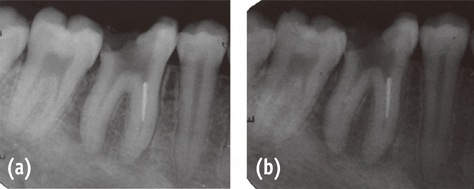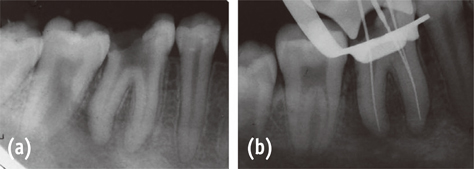Restor Dent Endod.
2013 May;38(2):93-97. 10.5395/rde.2013.38.2.93.
Retrieval of a separated nickel-titanium instrument using a modified 18-guage needle and cyanoacrylate glue: a case report
- Affiliations
-
- 1Department of Conservative Dentistry, Dr. Z. A. Dental College, Aligarh Muslim University, Aligarh, India. mukhtarandrabi@gmail.com
- KMID: 1995466
- DOI: http://doi.org/10.5395/rde.2013.38.2.93
Abstract
- During root canal preparation procedures, the potential for instrument breakage is always present. When instrument breakage occurs, it leads to anxiety of the clinician and as well as a metallic obstruction of the canal which hinders further cleaning and shaping. Separated instruments must always be attempted for retrieval and if retrieval is not possible bypass should be tried. With the increased use of nickel-titanium (NiTi) instruments the incidence of separated instruments has increased. A considerable amount of research has been done to understand the various factors related to the fracture of NiTi instruments to minimize its occurrence. This paper presents a review of the literature regarding the fracture of NiTi instruments and also describes a case report showing the use of a modified 18-guage needle and cyanoacrylate glue to retrieve a separated NiTi instrument from the mesiolingual canal of a mandibular first molar.
Keyword
MeSH Terms
Figure
Cited by 1 articles
-
The top 10 most-cited articles on the management of fractured instruments: a bibliometric analysis
Lora Mishra, Hyeon-Cheol Kim, Naomi Ranjan Singh, Priti Pragati Rath
Restor Dent Endod. 2019;44(1):. doi: 10.5395/rde.2019.44.e2.
Reference
-
1. Hülsmann M. Removal of silver cones and fractured instruments using the canal finder system. J Endod. 1990; 16:596–600.
Article2. Fors UG, Berg JO. Endodontic treatment of root canals obstructed by foreign objects. Int Endod J. 1986; 19:2–10.
Article3. Vaudt J, Bitter K, Neumann K, Kielbassa AM. Ex vivo study on root canal instrumentation of two rotary nickel-titanium systems in comparison to stainless steel hand instruments. Int Endod J. 2009; 42:22–33.
Article4. Bonaccorso A, Cantatore G, Condorelli GG, Schäfer E, Tripi TR. Shaping ability of four nickel-titanium rotary instruments in simulated S-shaped canals. J Endod. 2009; 35:883–886.
Article5. Carvalho LA, Bonetti I, Borges MA. A comparison of molar root canal preparation using stainless-steel and Nickel-Titanium instruments. J Endod. 1999; 25:807–810.
Article6. Sattapan B, Nervo GT, Palamara JE, Messer HH. Defects in rotary nickel-titanium files after clinical use. J Endod. 2000; 26:161–165.
Article7. Hülsmann M, Schinkel I. Influence of several factors on the success or failure of removal of fractured instruments from the root canal. Endod Dent Traumatol. 1999; 15:252–258.
Article8. Thompson SA. An overview of nickel-titanium alloys used in dentistry. Int Endod J. 2000; 33:297–310.
Article9. Plotino G, Pameijer CH, Grande NM, Somma F. Ultrasonics in endodontics: a review of the literature. J Endod. 2007; 33:81–95.
Article10. Cujé J, Bargholz C, Hülsmann M. The outcome of retained instrument removal in a specialist practice. Int Endod J. 2010; 43:545–554.
Article11. Alapati SB, Brantley WA, Svec TA, Powers JM, Nusstein JM, Daehn GS. SEM observations of nickel-titanium rotary endodontic instruments that fractured during clinical use. J Endod. 2005; 31:40–43.
Article12. Askeland DR, Phule PF. The science and engineering of materials. 4th ed. California: Brooks/Cole-Thomson Learning;2003.13. Spanaki-Voreadi AP, Kerezoudis NP, Zinelis S. Failure mechanism of ProTaper Ni-Ti rotary instruments during clinical use: fractographic analysis. Int Endod J. 2006; 39:171–178.
Article14. Parashos P, Gordon I, Messer HH. Factors influencing defects of rotary nickel titanium endodontic instruments after clinical use. J Endod. 2004; 30:722–725.
Article15. Souter NJ, Messer HH. Complications associated with fractured file removal using an ultrasonic technique. J Endod. 2005; 31:450–452.
Article16. Torabinejad M, Lemon RR. Procedural accidents. In : Walton RE, Torabinejad M, editors. Principles and practice of endodontics. 3rd ed. Philadelphia: Saunders;2002. p. 310–330.17. Spili P, Parashos P, Messer HH. The impact of instrument fracture on outcome of endodontic treatment. J Endod. 2005; 31:845–850.
Article18. Ruddle CJ. Nonsurgical retreatment. J Endod. 2004; 30:827–845.
Article
- Full Text Links
- Actions
-
Cited
- CITED
-
- Close
- Share
- Similar articles
-
- Percutaneous Nephrostomy Using 18 Guage Puncture Needle
- The effect of gutta-percha removal using nickel-titanium rotary instruments
- The Results of Cyanoacrylate Glue Application for Corneal Perforation and Impending Perforation
- Mechanical properties of nickel titanium and steel alloys under stress- strain test
- 2-Octyl Cyanoacrylate Glue Application on Split-Thickness Skin Graft for Lower Extremity Reconstruction






